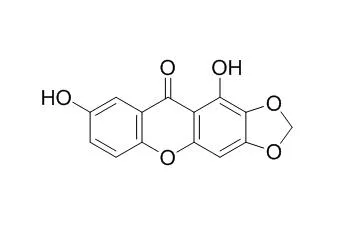Polygala cyparissias, used in folk medicine as an anaesthetic, has already demonstrated antinociceptive activity against acute pain.
METHODS AND RESULTS:
In this study, we investigated the antihyperalgesic activity of the P. cyparissias methanol extract (PCME) from which the following compounds were isolated: α-spinasterol (PC1), 1,3-dihydroxy-7-methoxyxanthone (PC2), 1,7-Dihydroxy-2,3-methylenedioxyxanthone (PC3) and 1,3,6,8-tetrahydroxy-2,7-dimethoxyxanthone (PC4). The antihyperalgesic effect was evaluated using experimental models of persistent pain induced by carrageenan, lipopolysaccharide (LPS), Freund's Complete Adjuvant (CFA), PGE(2) or epinephrine. The partial ligation of the sciatic nerve (PLSN) model was also used. In inflammatory hyperalgesia induced by carrageenan, LPS, CFA or PGE(2), the inhibition values obtained with the PCME treatment were 68 ± 3%, 89 ± 5%, 43 ± 3% and 40 ± 4%, respectively. In epinephrine-induced hyperalgesia, the extract was effective, reducing 99 ± 11% of response frequency, while in PLSN, 54 ± 4% of inhibition was obtained. These results allow to suggest that the antihyperalgesic activity of PCME is, at least in part, related to its capability to inhibit the hypersensitization induced by pro-inflammatory mediators, such as LPS, carrageenan and CFA, without interfering with locomotor activity or motor performance. Furthermore, compounds PC1, PC3 and PC4 inhibited the carrageenan-induced hyperalgesia with inhibition of 42 ± 6%, 48 ± 5% and 64 ± 4%, respectively.
CONCLUSIONS:
In summary, our data demonstrate that PCME has relevant antihyperalgesic activity and that the isolated PC1, PC3 and PC4 seem to be responsible, at least in part, for this important effect. |






 Cell. 2018 Jan 11;172(1-2):249-261.e12. doi: 10.1016/j.cell.2017.12.019.IF=36.216(2019)
Cell. 2018 Jan 11;172(1-2):249-261.e12. doi: 10.1016/j.cell.2017.12.019.IF=36.216(2019) Cell Metab. 2020 Mar 3;31(3):534-548.e5. doi: 10.1016/j.cmet.2020.01.002.IF=22.415(2019)
Cell Metab. 2020 Mar 3;31(3):534-548.e5. doi: 10.1016/j.cmet.2020.01.002.IF=22.415(2019) Mol Cell. 2017 Nov 16;68(4):673-685.e6. doi: 10.1016/j.molcel.2017.10.022.IF=14.548(2019)
Mol Cell. 2017 Nov 16;68(4):673-685.e6. doi: 10.1016/j.molcel.2017.10.022.IF=14.548(2019)